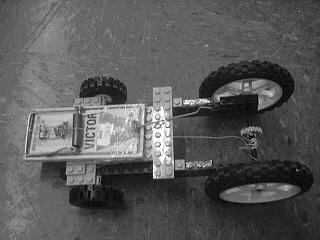Difference between revisions of "Mousetrap Vehicle Competition"
| Line 38: | Line 38: | ||
Mass of the object affects the amount of rotational inertia, the greater the | Mass of the object affects the amount of rotational inertia, the greater the | ||
mass, the greater the rotational inertia.</p> | mass, the greater the rotational inertia.</p> | ||
<p align=center>[[Image:lab_Mousetrap_3.jpg]]</p> | |||
<p class=caption>Figure 3: Small rotational inertia</p> | |||
<p align=center>[[Image:lab_Mousetrap_4.jpg]]</p> | |||
<p class=caption>Figure 4: Small rotational inertia</p> | |||
<p>Rotational inertia is also dependent on the location of mass from the axis of | <p>Rotational inertia is also dependent on the location of mass from the axis of | ||
Revision as of 18:16, 16 July 2005
EG1004 Lab 3A: Mousetrap Car
3A.1 Objective
Using your knowledge of gear ratios, torque, and other basic physics concepts, build a vehicle powered only by a standard sized mousetrap that will travel the farthest linear distance.
3A.2 Overview
A mousetrap car is a vehicle using a mousetrap as a propulsion source. In a traditional mousetrap car, a string is attached to the lever arm of the mousetrap and the other end of the string is attached to the drive axle.
Figure 1: Picture of a typical mousetrap car
The string is looped around a "hook" on the axle. As the string is wrapped around the axle, the mousetrap's lever arm will be pulled back. When the mousetrap is activated, the lever arm will pull the string, which in turn will rotate the drive axle and propel the vehicle forward.
Figure 2: A possible mousetrap car design
Principles involved in a Mousetrap Car
Friction:The force that resists the motion of two surfaces in contact. In a mousetrap car, a lot of power is lost due to friction between the axles and chassis and between the wheels and the ground. Not all friction is bad though; friction that prevents the wheels from slipping is called traction. In general, one may want to reduce the amount of friction, but have enough traction so that the wheels do not slip.
Rotational Inertia: The resistance an object has to changes in rotation. Mass of the object affects the amount of rotational inertia, the greater the mass, the greater the rotational inertia.
Figure 3: Small rotational inertia
Figure 4: Small rotational inertia
Rotational inertia is also dependent on the location of mass from the axis of rotation. The farther the bulk of mass is radially from the axis of rotation, the greater the rotational inertia.
Figure 5: Comparison of Rotational Inertia
3A.3 Your Assignment
This lab has no lab report or presentation. All you need to do is build a mousetrap car and participate in the competition.
Extra credit will be given on Lab 3 for the completion of a functional mousetrap car. Additional extra credit will be awarded to the winner of the competition. Make sure to get the sketch of the design signed by the TA as well as a photo and attach it to your lab report in order to receive extra credit. Your team may also want to include a picture and short description of your vehicle in your presentation.
3A.4 Competition Rules
- Only the Lego parts provided may be used.
- The vehicle must be powered solely by the mousetrap provided.
- The vehicle must have at least 1 wheel (no projectiles allowed)
- The mousetrap spring must not be physically altered.
- The vehicle may not receive a push at the start
- The vehicle cannot be touched once it has left the starting position.
- Displacement distance will be measured; not the total distance traveled.
- If the car hits another object (e.g. the wall), distance will be measured at the point of impact.
Scoring
The team with the greatest displacement distance traveled wins.
3A.5 Materials
- Robolab kit
- Mousetrap
- Kevlar string
- Tape
3A.6 Procedure
- Brainstorm about possible designs for a mousetrap car.
- Sketch your design on paper
- Construct your design based on your sketch
- The mousetrap may be attached to the car by tape (try not to use excessive amounts of tape; all tape should be removed from the Lego parts before leaving).
- Load the mousetrap by winding the string around the drive axle.
- Once your team is ready, position the vehicle behind the starting line and release it.
- Once the vehicle comes to a stop, your team may decide to keep the current distance or make quick modifications and try again. Each team is allowed up to 3 tries if time permits.
- Before leaving the room, the mousetrap car must be disassembled and all tape must be removed from the Lego parts.
Things to keep in mind when building a mousetrap car
- The position of mousetrap and length of the lever arm are important in determining the amount of torque wanted.
- Weight is an important factor in building mousetrap cars. A mousetrap may not have enough force to propel a heavy car. Weight will also affect the car's momentum.
- Use CAUTION when handling mousetraps (mousetrap hammers snap at 70mph).

